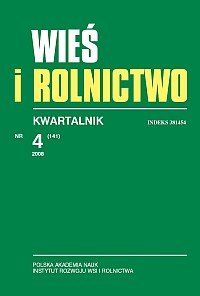„Drugie domy” a zrównoważony rozwój obszarów wiejskich
„Second Homes” and Sustainable Development of Rural Areas
Author(s): Adam Czarnecki, Krystian HeffnerSubject(s): Economy
Published by: Instytut Rozwoju Wsi i Rolnictwa Polskiej Akademii Nauk
Keywords: second homes; rural areas; local development; counter-urbanisation; seasonal (tourist) urbanization; drugie domy; obszary wiejskie; rozwój lokalny; kontrurbanizacja; urbanizacja sezonowa (turystyczna)
Summary/Abstract: The idea to possess a 'second home' is becoming increasingly popular and leads to the emergence of vast zones of concentration of such second homes in rural areas. This phenomenon attests to progressing urbanisation and gradual materialisation of the post-industrial paradigm of development through new trends in consumption and satisfaction of modern demand for tourist services. Various forms of realisation of the 'second home' need materialise chiefly in rural areas, impacting strongly on the structure of their space and its arrangement, as well as on social and economic relations. In the zones of concentration of this form of the urban population’s operation in rural areas significant changes become observable in the landscape, economic and social-cultural activity. 'Second homes' undoubtedly constitute a development opportunity for rural areas (mainly in respect of economic activity) but they also can impact negatively on the natural environment and rural landscape. The article presents an analysis of the evolution of views on the phenomenon of 'second homes' and discusses its meaning for the development of rural areas (in respect of economy, social relations and natural environment). The article marks also an attempt at arranging the principal definitions and research problems essential for the shaping of rural development in Poland. Intensywny rozwój zjawiska „drugich domów” oraz powstawanie rozległych obszarów ich koncentracji na obszarach wiejskich świadczy o postępującej urbanizacji oraz stopniowym urzeczywistnianiu się postindustrialnego paradygmatu rozwoju poprzez nowe trendy konsumpcyjne i zaspokajanie nowoczesnego popytu na usługi turystyczne. Różne formy realizacji potrzeby „drugich domów” materializują się przede głównie na obszarach wiejskich, silnie oddziałując na strukturę ich przestrzeni, jej zagospodarowanie oraz na stosunki społeczno-gospodarcze. W strefach koncentracji tej formy funkcjonowania mieszkańców miast na wsi dochodzi do istotnych zmian w krajobrazie, gospodarce i warstwie społeczno-kulturowej. „Drugie domy” stanowią niewątpliwie szansę rozwoju wsi (głównie w aspekcie ekonomicznym), ale powodować też mogą niekorzystne zmiany w środowisku przyrodniczym i krajobrazie wiejskim. W artykule prześledzono ewolucję poglądów na temat zjawiska „drugich domów” oraz znaczenia tego procesu dla rozwoju obszarów wiejskich (w sferze ekonomicznej, społecznej i przyrodniczej). Podjęto również próbę uporządkowania podstawowych terminów i problematyki badawczej istotnej dla kształtowania rozwoju obszarów wiejskich w Polsce.
Journal: Wieś i Rolnictwo
- Issue Year: 141/2008
- Issue No: 4
- Page Range: 29-46
- Page Count: 29
- Language: Polish

